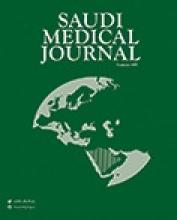To the Editor
Osteoporosis remains a global health problem associated with significant morbidity, mortality, and health care costs. The suggestion of establishing a fracture liaison service in Saudi Arabia by Alwahhabi is timely.1 However, it should be part of a national strategy. In addition, addressing vitamin D deficiency, smoking, and promoting exercise are all pivotal not only in the treatment and prevention of osteoporosis but many other diseases that has plagued the Middle East, as well as many parts of the world. Moderate physical activity, for example, can help prevent and manage not only osteoporosis but more than 20 conditions and diseases, including coronary heart disease, some cancers, metabolic syndrome, type 2 diabetes, musculoskeletal disorders, such as back pain, mild to moderate depression, and obesity.2 Individuals who increase their physical activity can significantly improve both their physical and mental wellbeing and reduce disease throughout life, in addition to improving life expectancy. A national audit programme is important in implementing any national guidance. On a more specific level, encouraging the use of the fracture risk assessment tool (FRAX) prior to requesting a dual energy x-ray absorptiometry (DEXA) scan saves time and money.
The term “osteopenia” implies disease and although it continues to be used, “low bone mass” or “low bone density” is preferred. People with low bone mass or density are not necessarily at high fracture risk. A recent study3 has given clear guidance as to when a DEXA scan needs to be repeated if the result is either normal or indicating osteopenia. The results indicate that osteoporosis would develop in less than 10% of older, postmenopausal women during rescreening intervals of approximately 15 years for women with normal bone density or mild osteopenia (T score -1 to -1.49), 5 years for women with moderate osteopenia (T score -1.5 to -1.99), and one year for women with advanced osteopenia (T score -2 -2.49) (Table 1).
Repeating dual energy x-ray absorptiometry (DEXA) if the bone mass density (BMD) is normal or showing osteopenia.
Reply from the Author
No reply was received from the Author
- Copyright: © Saudi Medical Journal
This is an open-access article distributed under the terms of the Creative Commons Attribution-Noncommercial-Share Alike 3.0 Unported, which permits unrestricted use, distribution, and reproduction in any medium, provided the original work is properly cited.






